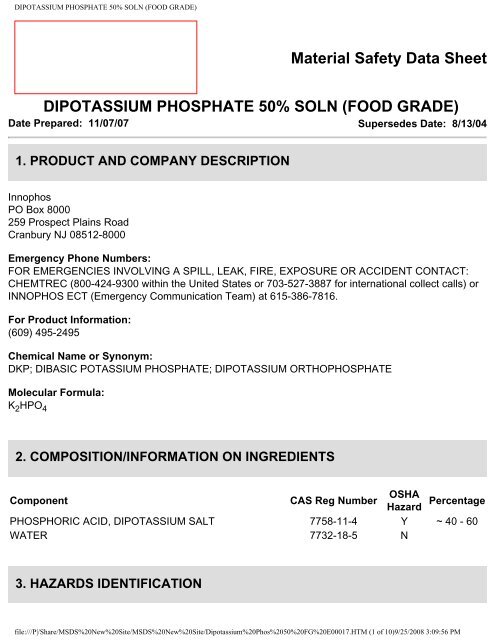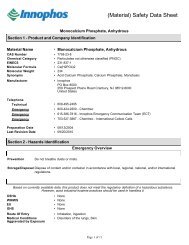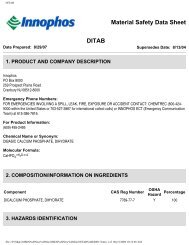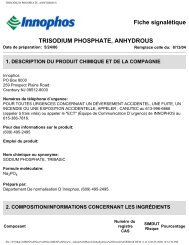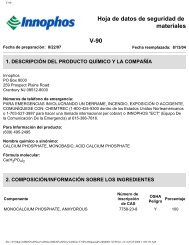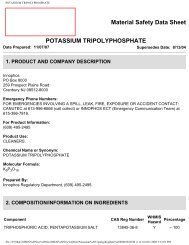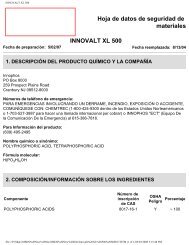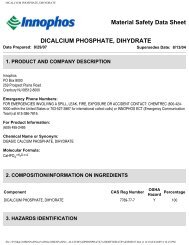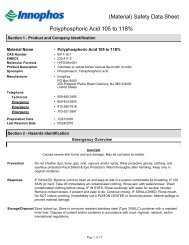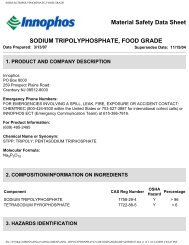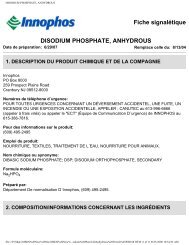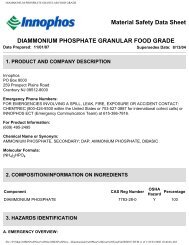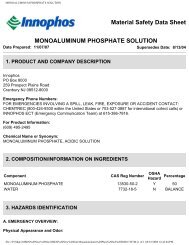DIPOTASSIUM PHOSPHATE 50% SOLN (FOOD GRADE) - Innophos
DIPOTASSIUM PHOSPHATE 50% SOLN (FOOD GRADE) - Innophos
DIPOTASSIUM PHOSPHATE 50% SOLN (FOOD GRADE) - Innophos
You also want an ePaper? Increase the reach of your titles
YUMPU automatically turns print PDFs into web optimized ePapers that Google loves.
<strong>DIPOTASSIUM</strong> <strong>PHOSPHATE</strong> <strong>50%</strong> <strong>SOLN</strong> (<strong>FOOD</strong> <strong>GRADE</strong>)resuscitation). Seek medical attention.Ingestion:Do not induce vomiting, unless directed to do so by a physician. If victim is conscious and alert, give 2-3 glasses of water to drink. Seek immediate medical attention. Do not leave victim unattended. Toprevent aspiration of swallowed product, lay victim on side with head lower than waist. Vomiting mayoccur spontaneously. If vomiting occurs and the victim is conscious, give water to further dilute thechemical. Also see Note To Physician.MEDICAL CONDITIONS POSSIBLY AGGRAVATED BY EXPOSURE:Inhalation of product may aggravate existing chronic respiratory problems such as asthma,emphysema or bronchitis. Skin contact may aggravate existing skin disease.NOTES TO PHYSICIAN:All treatments should be based on observed signs and symptoms of distress in the patient.Consideration should be given to the possibility that overexposure to materials other than this productmay have occurred.Ingestion of large quantities of phosphate salts (over 1.0 grams for an adult) may cause an osmoticcatharsis resulting in diarrhea and probable abdominal cramps. Larger doses such as 4-8 grams willalmost certainly cause these effects in everyone. In healthy individuals most of the ingested salt will beexcreted in the feces with the diarrhea and, thus, not cause any systemic toxicity. Doses greater than10 grams hypothetically may cause systemic toxicity. Treatment should take into consideration bothanionic and cation portion of the molecule. The following treatments should be considered for thespecific group(s) of phosphate salts found in this product:--All phosphate salts, except calcium salts, have a hypothetical risk of hypocalcemia, so calcium levelsshould be monitored.--Ammonium salts have a hypothetical risk of ammonia toxicity. In addition to calcium levels, ammoniaand phosphate levels should be monitored.--Potassium salts have a hypothetical risk of hyperkalemia which can cause cardiac arrhythmia. Inaddition to calcium levels, potassium and phosphate levels should be monitored. Also considercontinuous EKG monitoring to detect hyperkalemia.--Sodium salts have a hypothetical risk of hypernatremia. In addition to calcium levels, sodium andphosphate levels should be monitored.5. FIRE FIGHTING MEASURESFIRE HAZARD DATA:Flash Point:Not Applicablefile:///P|/Share/MSDS%20New%20Site/MSDS%20New%20Site/Dipotassium%20Phos%20<strong>50%</strong>20FG%20E00017.HTM (3 of 10)9/25/2008 3:09:56 PM
<strong>DIPOTASSIUM</strong> <strong>PHOSPHATE</strong> <strong>50%</strong> <strong>SOLN</strong> (<strong>FOOD</strong> <strong>GRADE</strong>)Extinguishing Media:Not combustible. Use extinguishing method suitable for surrounding fire.Special Fire Fighting Procedures:Firefighters should wear NIOSH/MSHA approved self-contained breathing apparatus and full protectiveclothing. Dike area to prevent runoff and contamination of water sources. Dispose of fire control waterlater.Unusual Fire and Explosion Hazards:Not combustible.Hazardous Decomposition Materials (Under Fire Conditions):oxides of phosphorusoxides of potassium6. ACCIDENTAL RELEASE MEASURESEvacuation Procedures and Safety:Wear appropriate protective gear for the situation. See Personal Protection information in Section 8.Containment of Spill:Follow procedure described below under Cleanup and Disposal of Spill.Cleanup and Disposal of Spill:Absorb with an inert absorbent. Sweep or vacuum up and place in an appropriate closed container(see Section 7: Handling and Storage). Clean up residual material by washing area with water anddetergent. Collect washings for disposal.Environmental and Regulatory Reporting:Do not flush to drain. Spills may be reportable to the National Response Center (800-424-8802) and tostate and/or local agencies.7. HANDLING AND STORAGEMinimum/Maximum Storage Temperatures:Not AvailableHandling:This is a food ingredient intended for human consumption. Keep containers closed when not beingused. Avoid breathing vapors and mists. Avoid direct or prolonged contact with skin and eyes.file:///P|/Share/MSDS%20New%20Site/MSDS%20New%20Site/Dipotassium%20Phos%20<strong>50%</strong>20FG%20E00017.HTM (4 of 10)9/25/2008 3:09:56 PM
<strong>DIPOTASSIUM</strong> <strong>PHOSPHATE</strong> <strong>50%</strong> <strong>SOLN</strong> (<strong>FOOD</strong> <strong>GRADE</strong>)Storage:Store in closed containers. Store in an area that is cool, dry, sanitary, well-ventilated.8. EXPOSURE CONTROLS/PERSONAL PROTECTIONIntroductory Remarks:These recommendations provide general guidance for handling this product. Because specific workenvironments and material handling practices vary, safety procedures should be developed for eachintended application. While developing safe handling procedures, do not overlook the need to cleanequipment and piping systems for maintenance and repairs. Waste resulting from these proceduresshould be handled in accordance with Section 13: Disposal Considerations.Assistance with selection, use and maintenance of worker protection equipment is generally availablefrom equipment manufacturers.Exposure Guidelines:No exposure limits were found for this product or any of its ingredients.Engineering Controls:Where engineering controls are indicated by use conditions or a potential for excessive exposureexists, the following traditional exposure control techniques may be used to effectively minimizeemployee exposures: local exhaust ventilation at the point of generation.Respiratory Protection:When respirators are required, select NIOSH/MSHA approved equipment based on actual or potentialairborne concentrations and in accordance with the appropriate regulatory standards and/or industrialrecommendations.Under normal conditions, in the absence of other airborne contaminants, the following devices shouldprovide protection from this material up to the conditions specified by the appropriate OSHA, WHMISor ANSI standard(s): Air-purifying (half-mask/full-face) respirator with cartridges/canister approved foruse against organic vapors.Eye/Face Protection:Eye and face protection requirements will vary dependent upon work environment conditions andmaterial handling practices. Appropriate ANSI Z87 approved equipment should be selected for theparticular use intended for this material.Eye contact should be prevented through use of chemical safety glasses with side shields or splashproof goggles. An emergency eye wash must be readily accessible to the work area.Skin Protection:Skin contact should be minimized through use of gloves and suitable long-sleeved clothing (i.e., shirtsand pants). Consideration must be given both to durability as well as permeation resistance.file:///P|/Share/MSDS%20New%20Site/MSDS%20New%20Site/Dipotassium%20Phos%20<strong>50%</strong>20FG%20E00017.HTM (5 of 10)9/25/2008 3:09:56 PM
<strong>DIPOTASSIUM</strong> <strong>PHOSPHATE</strong> <strong>50%</strong> <strong>SOLN</strong> (<strong>FOOD</strong> <strong>GRADE</strong>)Work Practice Controls:Personal hygiene is an important work practice exposure control measure and the following generalmeasures should be taken when working with or handling this material:(1) Do not use, and/or consume foods, beverages, tobacco products, or cosmetics in areaswhere this material is stored.(2) Wash hands and face carefully before eating, drinking, using tobacco, applying cosmetics,or using the toilet.(3) Wash exposed skin promptly to remove accidental splashes or contact with this material.9. PHYSICAL AND CHEMICAL PROPERTIESPhysical and Chemical properties here represent typical properties of this product. Contact thebusiness area using the Product Information phone number in Section 1 for its exact specifications.Physical Appearance:clear / liquid.Odor:odorless.pH:10 to 10.3 at 50 wt/wt%.Specific Gravity:1.54 at 15 C (59 F).Density:1.54 g/ml at 15 C (59 F).Water Solubility:solubleMelting Point Range:Not AvailableBoiling Point Range:106 C (223 F) at mmHgVapor Pressure:0.1 mmHg at 20 C (68 F)Vapor Density:Not AvailableMolecular Weight:file:///P|/Share/MSDS%20New%20Site/MSDS%20New%20Site/Dipotassium%20Phos%20<strong>50%</strong>20FG%20E00017.HTM (6 of 10)9/25/2008 3:09:56 PM
<strong>DIPOTASSIUM</strong> <strong>PHOSPHATE</strong> <strong>50%</strong> <strong>SOLN</strong> (<strong>FOOD</strong> <strong>GRADE</strong>)175.310. STABILITY AND REACTIVITYChemical Stability:This material is stable under normal handling and storage conditions described in Section 7.Conditions To Be Avoided:none knownMaterials/Chemicals To Be Avoided:none knownThe Following Hazardous Decomposition Products Might Be Expected:Decomposition Type: thermaloxides of phosphorusoxides of potassiumHazardous Polymerization Will Not Occur.Avoid The Following To Inhibit Hazardous Polymerization:not applicable11. TOXICOLOGICAL INFORMATIONAcute Eye Irritation:No test data found for product.Acute Skin Irritation:No test data found for product.Acute Dermal Toxicity:Toxicological Information and Interpretation:LD50 - lethal dose <strong>50%</strong> of test species, > 5000 mg/kg, rabbit.Acute Respiratory Irritation:No test data found for product.Acute Inhalation Toxicity:No test data found for product.file:///P|/Share/MSDS%20New%20Site/MSDS%20New%20Site/Dipotassium%20Phos%20<strong>50%</strong>20FG%20E00017.HTM (7 of 10)9/25/2008 3:09:56 PM
<strong>DIPOTASSIUM</strong> <strong>PHOSPHATE</strong> <strong>50%</strong> <strong>SOLN</strong> (<strong>FOOD</strong> <strong>GRADE</strong>)Acute Oral Toxicity:Toxicological Information and Interpretation:LD50 - lethal dose <strong>50%</strong> of test species, > 4810 mg/kg, rat.Chronic Toxicity:This product does not contain any substances that are considered by OSHA, NTP, IARC or ACGIH tobe "probable" or "suspected" human carcinogens.12. ECOLOGICAL INFORMATIONEcotoxicological Information:No data found for product.Chemical Fate Information:No specific biodegradation test data located. While the alkalinity of this material is readily reduced innatural waters, the resulting phosphate may persist indefinitely or incorporate into biological systems.13. DISPOSAL CONSIDERATIONSWaste Disposal Method:Chemical additions, processing or otherwise altering this material may make the waste managementinformation presented in this MSDS incomplete, inaccurate or otherwise inappropriate. Please beadvised that state and local requirements for waste disposal may be more restrictive or otherwisedifferent from federal laws and regulations. Consult state and local regulations regarding the properdisposal of this material.EPA Hazardous Waste - YESEPA RCRA HAZARDOUS WASTE CODES:"C" Corrosive.14. TRANSPORTATION INFORMATIONTransportation Status: IMPORTANT! Statements below provide additional data on listed DOTclassification.The listed Transportation Classification does not address regulatory variations due to changes inpackage size, mode of shipment or other regulatory descriptors. In the United States, it may bepossible to reclassify this material as not regulated via surface transportation because its corrosivity isdue solely to its effect on metals (either steel or aluminum). See 49 CFR 173.154(d).file:///P|/Share/MSDS%20New%20Site/MSDS%20New%20Site/Dipotassium%20Phos%20<strong>50%</strong>20FG%20E00017.HTM (8 of 10)9/25/2008 3:09:56 PM
<strong>DIPOTASSIUM</strong> <strong>PHOSPHATE</strong> <strong>50%</strong> <strong>SOLN</strong> (<strong>FOOD</strong> <strong>GRADE</strong>)US Department of TransportationHazard Class..... 8Shipping Name:CORROSIVE LIQUID, BASIC, INORGANIC, N.O.S.Technical Shipping Name:PHOSPHORIC ACID, <strong>DIPOTASSIUM</strong> SALTID Number....... UN3266Packing Group.... IIILabels........... CORROSIVEEmergency Guide #.... 15415. REGULATORY INFORMATIONInventory StatusInventory StatusUNITED STATES (TSCA)YCANADA (DSL)YEUROPE (EINECS/ELINCS)YAUSTRALIA (AICS)YJAPAN (MITI)YSOUTH KOREA (KECL)YY = All ingredients are on the inventory.E = All ingredients are on the inventory or exempt from listing.P = One or more ingredients fall under the polymer exemption or are on the no longer polymer list. Allother ingredients are on the inventory or exempt from listing.N = Not determined or one or more ingredients are not on the inventory and are not exempt fromlisting.FEDERAL REGULATIONSInventory Issues:All functional components of this product are listed on the TSCA Inventory.SARA Title III Hazard Classes:Fire HazardReactive HazardRelease of PressureAcute Health HazardChronic Health Hazard- NO- NO- NO- YES- NOfile:///P|/Share/MSDS%20New%20Site/MSDS%20New%20Site/Dipotassium%20Phos%20<strong>50%</strong>20FG%20E00017.HTM (9 of 10)9/25/2008 3:09:56 PM
<strong>DIPOTASSIUM</strong> <strong>PHOSPHATE</strong> <strong>50%</strong> <strong>SOLN</strong> (<strong>FOOD</strong> <strong>GRADE</strong>)OTHER FEDERAL REGULATIONS:FDA Status:This product meets the compositional requirements of:21 CFR 182.6285 <strong>DIPOTASSIUM</strong> <strong>PHOSPHATE</strong>STATE REGULATIONS:This product does not contain any components that are regulated under California Proposition 65.16. OTHER INFORMATIONNational Fire Protection Association Hazard Ratings--NFPA(R):2 Health Hazard Rating--Moderate0 Flammability Rating--Minimal0 Instability Rating--MinimalNational Paint & Coating Hazardous Materials Identification System--HMIS(R):2 Health Hazard Rating--Moderate0 Flammability Rating--Minimal0 Reactivity Rating--MinimalReason for Revisions:Change and/or addition made to Section 3, Section 4, Section 6.Key Legend Information:ACGIH - American Conference of Governmental Industrial HygienistsOSHA - Occupational Safety and Health AdministrationTLV - Threshold Limit ValuePEL - Permissable Exposure LimitTWA - Time Weighted AverageSTEL - Short Term Exposure LimitNTP - National Toxicology ProgramIARC - International Agency for Research on CancerND - Not determinedRPI - INNOPHOS Established Exposure LimitsDisclaimer:The information herein is given in good faith but no warranty, expressed or implied, is made.** End of MSDS Document **file:///P|/Share/MSDS%20New%20Site/MSDS%20New%20Site/Dipotassium%20Phos%20<strong>50%</strong>20FG%20E00017.HTM (10 of 10)9/25/2008 3:09:56 PM


